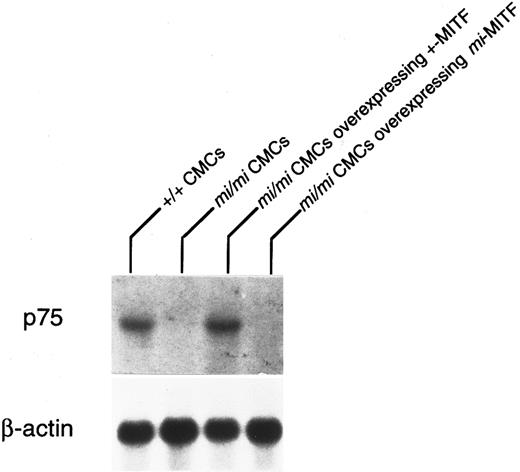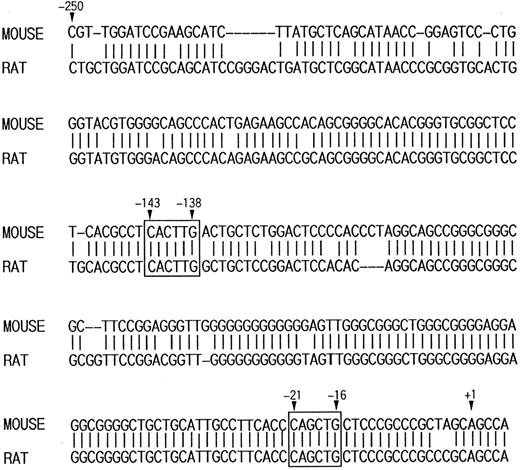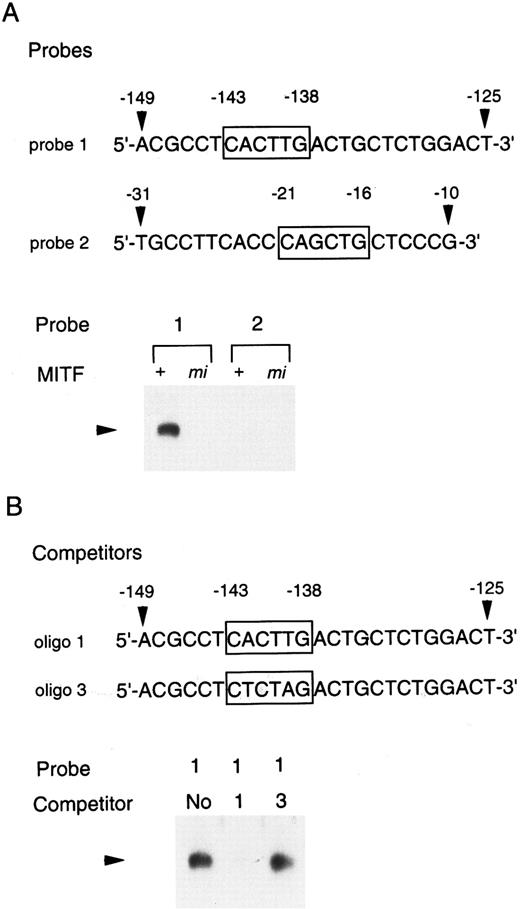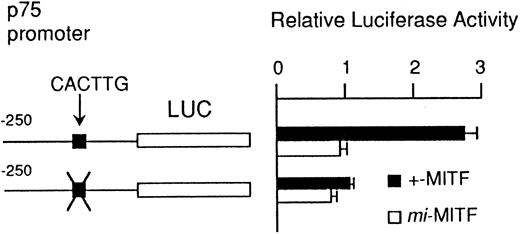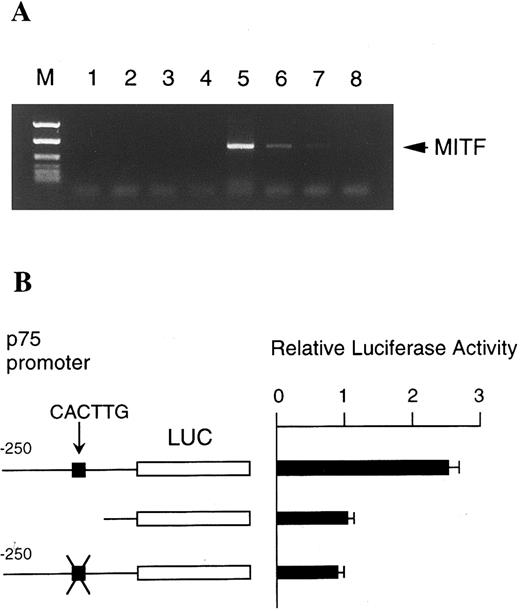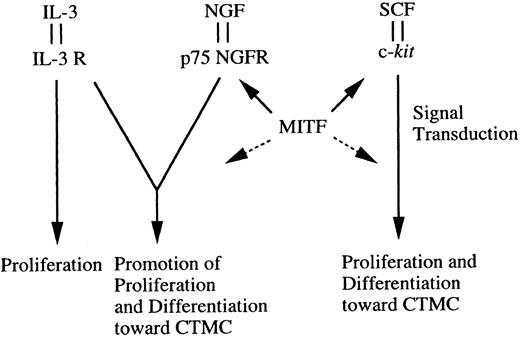Abstract
The mi locus of mice encodes a member of the basic-helix-loop-helix-leucine zipper (bHLH-Zip) protein family of transcription factors (hereafter called MITF ). Cultured mast cells (CMCs) of mi/mi genotype showed a poor response to nerve growth factor (NGF ). Addition of NGF to the suboptimal dose of interleukin-3 (IL-3) increased the plating efficiency of normal (+/+) CMCs but not mi/mi CMCs. Although +/+ CMCs were berberine sulfate–negative when cultured with IL-3, +/+ CMCs became berberine sulfate–positive when cultured in the presence of both IL-3 and NGF, which suggested increased heparin content. In contrast, NGF did not influence the phenotype of mi/mi CMCs. The poor response of mi/mi CMCs to NGF was attributed to the deficient expression of p75 NGF receptor. The purpose of the present study is to examine the effect of MITF on p75 gene transcription. Overexpression of +-MITF or mi-MITF was observed in mi/mi CMCs to which cDNA encoding each type of MITF had been introduced using the retroviral vector. Overexpression of +-MITF but not of mi-MITF normalized the expression of p75 and the above-mentioned poor responses of mi/mi CMCs to NGF, indicating the involvement of +-MITF in p75 gene transactivation. Then, we analyzed the promoter of the p75 gene. Two CANNTG motifs recognized by bHLH-Zip–type transcription factors were conserved between the mouse and rat p75 promoters. One of these two CANNTG motifs was specifically bound by +-MITF. When the luciferase gene under the control of the p75 promoter was cotransfected into NIH/3T3 fibroblasts with cDNA encoding +-MITF or mi-MITF, luciferase activity increased significantly only when +-MITF cDNA was cotransfected. The mutation of this CANNTG motif abolished the transactivation effect of +-MITF, indicating that +-MITF transactivated the p75 gene, at least in part, through direct binding.
THE mi LOCUS on chromosome 6 of mice encodes a member of the basic-helix-loop-helix-leucine zipper (bHLH-Zip) protein family of transcription factors (hereafter called MITF ).1,2 The MITF of mi/mi mutant mice deletes one of four consecutive arginines in the basic domain.1,3,4 The mi/mi mice show microphthalmia, depletion of pigment in hair and eyes, osteopetrosis, and a decrease in the number of mast cells.5-9 In addition to the decrease in number, the phenotype of mast cells was abnormal in mi/mi mice.10-13 In the skin of normal (+/+) mice, most mast cells were stained with berberine sulfate that bound heparin proteoglycan,14-17 and half of them expressed the mouse mast cell protease-6 (MMCP-6) gene.11 In contrast, only few mast cells were berberine sulfate–positive and MMCP-6 mRNA–positive in the skin of mi/mi mice.11 Expression of the MMCP-6 gene was also markedly reduced in cultured mast cells (CMCs) derived from the spleen of mi/mi mice.10 13
Interleukin-3 (IL-3) or stem cell factor (SCF ) promote proliferation and differentiation of mast cells.18,19 In addition, nerve growth factor (NGF ) has been reported to promote proliferation and differentiation of mast cells in the presence of suboptimal doses of IL-3.20 The proliferative response of mi/mi CMCs to IL-3 was comparable to that of normal (+/+) CMCs. In contrast, mi/mi CMCs did not respond normally to both SCF and NGF.10,13 The poor response of mi/mi CMCs to SCF was attributed to the reduced expression of c-kit, the receptor of SCF.10 We previously reported that the poor response of mi/mi CMCs to NGF was attributable to impaired expression of the p75 NGF receptor.13
Transcription factors of the bHLH-Zip protein family, including MITF, recognize a consensus sequence of the CANNTG motif.21 We have shown the binding of normal MITF (hereafter called +-MITF ) to CANNTG motifs in the 5′ flanking region of c-kit22 and MMCP-6 genes,23 the expression of which was markedly reduced in both mi/mi CMCs and mi/mi skin mast cells.10,11 We have also shown the loss of DNA binding ability and nuclear localization potential of the mutant MITF encoded by the mi mutant allele (hereafter called mi-MITF ).24 25 In the present study, we examined whether MITF directly regulated transcription of the p75 gene in mast cells. We introduced cDNA encoding +-MITF or mi-MITF into mi/mi CMCs and found that overexpression of +-MITF but not mi-MITF normalized the mRNA expression of the p75 gene and the poor response of mi/mi CMCs to NGF. +-MITF but not mi-MITF bound the CACTTG motif in the 5′ flanking region of the p75 gene. The luciferase gene under the control of the p75 promoter was transactivated by cotransfection of cDNA encoding +-MITF.
MATERIALS AND METHODS
Mice.The original stock of C57BL/6-mi/+ (mi/+) mice was purchased from the Jackson Laboratory (Bar Harbor ME) and maintained in our laboratory by consecutive backcrosses to our own inbred C57BL/6 colony (>15 generations at the time of the present experiment). Female and male mi/+ mice were crossed together, and the resulting mi/mi mice were selected by their white coat color.5 6
Reagents.NGF purified from murine submaxillary glands was a gift from Drs A.M. Stanisz and J. Bienenstock (McMaster University, Hamilton, Ontario, Canada). On polyacrylamide gel electrophoresis, the preparation used in the present experiment showed a single protein band at 27 kD (2.5S NGF dimer).26 Mouse recombinant murine (rm)IL-3 was a generous gift from Kirin Brewery Co (Tokyo, Japan).
Normalization of p75 expression in mi/mi CMCs by introduction of +-MITF cDNA. The Northern blot was hybridized with a 32P-labeled cDNA probe of p75 or β-actin.
Normalization of p75 expression in mi/mi CMCs by introduction of +-MITF cDNA. The Northern blot was hybridized with a 32P-labeled cDNA probe of p75 or β-actin.
Cells.Pokeweed mitogen–stimulated spleen cell–conditioned medium (PWM-SCM) was prepared according to the method described by Nakahata et al.27 Mice of the mi/mi genotype and control C57BL/6-+/+ (+/+) mice were used at 2 to 3 weeks of age to obtain CMCs. Mice were killed by decapitation after ether anesthesia, and the spleens were removed. Spleen cells derived from mi/mi or +/+ mice were cultured in α-minimal essential medium ([α-MEM] ICN Biomedicals, Costa Mesa, CA) supplemented with 10% PWM-SCM and 10% fetal calf serum (FCS; Nippon Biosupp Center, Tokyo, Japan). Half of the medium was replaced every 7 days, and greater than 95% of cells were CMCs 4 weeks after initiation of the culture.16 The helper virus–free packaging cell line (Ψ2)28 was maintained in Dulbecco's modified Eagle's medium ([DMEM] ICN Biomedicals) supplemented with 10% FCS. The NIH/3T3 fibroblast cell line was generously provided by Dr S.A. Aaronson (National Cancer Institute, Bethesda, MD) and maintained in DMEM supplemented with 10% FCS. The PC12 pheochromocytoma cell line was maintained in DMEM supplemented with 10% horse serum and 5% FCS. The IC-2 cell line was provided by Dr I. Yahara (Tokyo Metropolitan Institute of Medical Science, Tokyo, Japan)29 and maintained in α-MEM supplemented with 10% PWM-SCM and 10% FCS.
Construction of retrovirus vector and its infection.Bluescript KS (−) plasmids (pBS; Stratagene, La Jolla, CA) containing the whole coding region of +-MITF or mi-MITF (pBS-+-MITF and pBS-mi-MITF, respectively) had been constructed in our laboratory.24,25 A retroviral vector, pM5Gneo,30 a derivative of myeloproliferative sarcoma virus vector, was a kind gift from Dr W. Ostertag (Universität Hamburg, Hamburg, Germany). The purified Sma I-HincII fragment from pBS-+-MITF or pBS-mi-MITF was introduced into the blunted EcoRI site of pM5Gneo. The resulting pM5Gneo-+-MITF and pM5Gneo-mi-MITF were transfected into the packaging cell line (Ψ2)28 by the calcium phosphate precipitation method,31 and neomycin-resistant Ψ2 cell clones were selected by culturing in DMEM supplemented with 10% FCS and G418 (0.8 mg/mL; GIBCO-BRL, Grand Island, NY). For gene transfer, spleen cells obtained from mi/mi mice were incubated on an irradiated (30 Gy) subconfluent monolayer of virus-producing Ψ2 cells for 72 hours in α-MEM supplemented with 10% PWM-SCM and 10% FCS. Neomycin-resistant CMCs were obtained by continuing the culture in α-MEM containing 10% PWM-SCM, 10% FCS, and G418 (0.8 mg/mL) for 4 weeks. In our previous study, Northern blot analysis showed apparent expression of the introduced +-MITF or mi-MITF cDNA in mi/mi CMCs, whereas mRNA expression of the endogenous mi gene was hardly detectable in either +/+ CMCs or mi/mi CMCs.22 23
Northern blot analysis.Total RNA from CMCs was prepared by the lithium chloride–urea method.32 Northern blot analysis was performed using p75 and mouse β-actin33 cDNAs labeled with α-[32P]-deoxycytidine triphosphate ([dCTP] DuPont/NEN Research Products, Boston, MA; 10 mCi/mL) by random oligonucleotide priming as probes. For generation of the p75 probe, a PstI/AvaI-digested 459–base pair fragment of p75 cDNA (nucleotide [nt] 390 to 848) was used.34 After hybridization at 42°C, blots were washed to a final stringency of 0.2× SSC (1× SSC is 150 mmol/L NaCl and 15 mmol/L trisodium citrate, pH 7.4) at 50°C and subjected to autoradiography.
Binding of 125I-NGF to CMCs.Aliquots of 50 μL from CMC suspensions (2.0 × 107/mL) were incubated for 45 minutes at 37°C with 50 μL of various concentrations of 125I-NGF (Amersham, Arlington Heights, IL) in α-MEM containing 10% FCS. Radioactivity associated with CMCs was measured with a gamma counter (γ 5000; Packard, Meriden, CT). Nonspecific binding was determined in parallel experiments in the presence of a 100-fold excess of unlabeled NGF. Specific binding was determined by subtracting the nonspecific binding from total counts.
Clonal cell culture.Methylcellulose culture was performed using a modification of the technique described by Nakahata et al.27 Ten thousand CMCs were cultured in 1 mL α-MEM containing 0.9% methylcellulose (Sigma, St Louis, MO), 30% FCS, 10−4 mol/L 2-ME, 1% bovine serum albumin (Sigma), 50 U/mL penicillin, 50 mg/mL streptomycin, and 50 U/mL rmIL-3, with or without various doses of NGF. Culture dishes were incubated at 37°C in a humidified atmosphere of 5% CO2 in air. Mast cell colonies containing at least 20 cells were identified according to the criteria described by Nakahata et al27 and counted under an inverted microscope.
Staining.Individual colonies were removed from methylcellulose cultures by Pasteur pipette under inverted-microscope visualization and placed onto glass slides. The preparations were fixed in Carnoy's fluid and stained with 0.025% berberine sulfate (Sigma) at pH 2.5. Fluorescent intensity of the cells in mast cell colonies was determined using a system photometer (OSP-1; Olympus Japan, Tokyo, Japan), which can detect the fluorescence of individual cells stained with berberine sulfate.14,20 Because the fluorescence of berberine sulfate was abolished by treatment with heparinase but not by treatment with chondroitinase ABC,14 16 fluorescence was considered to indicate the presence of heparin proteoglycan.
Electrophoretic gel mobility shift assay.The production and purification of glutathione-S-transferase (GST)-+-MITF and GST-mi-MITF fusion proteins were described previously.24 25 Oligonucleotides were labeled with α-[32P]-dCTP by filling 5′-overhangs, and were used as probes for electrophoretic gel mobility shift assay (EGMSA). DNA binding assays were performed in a 20-μL reaction mixture containing 10 mmol/L Tris hydrochloride (pH 8.0), 1 mmol/L EDTA, 75 mmol/L KCl, 1 mmol/L dithiothreitol, 4% Ficoll type 400, 50 ng poly(dI-dC), 25 ng of the labeled DNA probe, and 3.5 mg GST-+-MITF or GST-mi-MITF fusion protein. After incubation at room temperature for 15 minutes, the reaction mixture was subjected to electrophoresis at 14 V/cm at 4°C on a 5% polyacrylamide gel in 0.25× TBE buffer (1× TBE is 90 mmol/L Tris hydrochloride, 64.6 mmol/L boric acid, and 2.5 mmol/L EDTA, pH 8.3). The polyacrylamide gels were dried on Whatman 3MM chromatography paper (Whatman, Maidstone, UK) and subjected to autoradiography. Competitive DNA binding assays were performed as already described, except that the unlabeled competitive DNA was added to the reaction mixture before addition of GST-+-MITF fusion protein.
Construction of effector and reporter plasmids.pEF-BOS expression vector35 was kindly provided by Dr S. Nagata (Osaka University Medical School, Osaka, Japan). The Sma I-HincII fragment of pBS-+-MITF or pBS-mi-MITF was introduced into the blunted Xba I site of pEF-BOS. The resulting pEF-+-MITF and pEF-mi-MITF expression vectors were used as effectors. The luciferase gene subcloned into pSP72 (pSPLuc)36 was generously provided by Dr K. Nakajima (Osaka University Medical School, Osaka, Japan). To construct reporter plasmids, a DNA fragment containing a promoter region and the first exon (noncoding region) of the p75 gene (nt -250 to +35; +1 is the transcription initiation site)37 was cloned into the upstream region of the luciferase gene in pSPLuc. The mutations were introduced by PCR with mismatched primers. Mutated products were verified by sequencing.
Transient assay.NIH/3T3 cells (5 × 105) were plated in a 10-cm dish 1 day before the procedure. Cotransfection with 10 μg of a reporter, 100 ng of an effector, and 2 μg of an expression vector containing the β-galactosidase gene was performed by the calcium phosphate precipitation method.31 The expression vector containing the β-galactosidase gene was used as an internal control. For transfection of the genes into PC12 cells, the reporter, effector, and expression vector containing the β-galactosidase gene were added to the cell suspension (1 × 107) in 0.7 mL phosphate-buffered saline, mixed gently, and incubated on ice for 10 minutes. Since IC-2 cells expressed effector gene by themselves, the reporter and the expression vector containing the β-galactosidase gene were added to the cell suspension. For gene transfer, cells were electroporated by a single pulse (975 microfarads at 350 V) from a Gene Pulser II (Bio-Rad Laboratories, Richmond, CA). After incubation on ice for 10 minutes, the cells were suspended in 10 mL complete culture medium. NIH/3T3 and PC12 cells were harvested 48 hours after transfection; IC-2 cells were harvested 8 hours after transfection. Cells were lysed with 0.1 mol/L potassium phosphate buffer (pH 7.4) containing 1% Triton X-100 (Sigma). Extracts were then used to assay luciferase activity with luminometer model LB96P (Berthold, Wildbad, Germany), and β-galactosidase activity. Luciferase activity was normalized by β-galactosidase activity and total protein concentration according to the method described by Yasumoto et al.38 The normalized value was divided by the value obtained with cotransfection of the reporter and pEF-BOS, and was expressed as relative luciferase activity.
Comparison of 5′ promoter region between mouse and rat p75 genes. CANNTG motifs are boxed. The transcription initiation site (+1) is also indicated.
Comparison of 5′ promoter region between mouse and rat p75 genes. CANNTG motifs are boxed. The transcription initiation site (+1) is also indicated.
Binding of +-MITF to the CACTTG motif in the 5′ flanking region of the p75 gene. (A) EGMSA using GST-+-MITF and GST-mi-MITF fusion proteins. The 5′-ACGCCTCACTTGACTGCTCTGGACT oligonucleotide containing a CACTTG motif (probe 1, nt −149 to −125; numbers refer to the sequence shown in Fig 2) and the 5′-TGCCTTCACCCAGCTGCTCCCG oligonucleotide containing a CAGCTG motif (probe 2, nt −31 to −10) were used (CANNTG motifs are boxed). The DNA-protein complex is indicated by an arrowhead. (B) Competitive DNA binding assay with GST-+-MITF. Two competitors were synthesized. Oligo 1 was identical to probe 1; oligo 3 had the mutation at the CACTTG motif (to CTCTAG). DNA-protein complexes are indicated by an arrowhead.
Binding of +-MITF to the CACTTG motif in the 5′ flanking region of the p75 gene. (A) EGMSA using GST-+-MITF and GST-mi-MITF fusion proteins. The 5′-ACGCCTCACTTGACTGCTCTGGACT oligonucleotide containing a CACTTG motif (probe 1, nt −149 to −125; numbers refer to the sequence shown in Fig 2) and the 5′-TGCCTTCACCCAGCTGCTCCCG oligonucleotide containing a CAGCTG motif (probe 2, nt −31 to −10) were used (CANNTG motifs are boxed). The DNA-protein complex is indicated by an arrowhead. (B) Competitive DNA binding assay with GST-+-MITF. Two competitors were synthesized. Oligo 1 was identical to probe 1; oligo 3 had the mutation at the CACTTG motif (to CTCTAG). DNA-protein complexes are indicated by an arrowhead.
Effect of coexpression of cDNA encoding +-MITF or mi-MITF on luciferase activity. The luciferase gene under control of the normal or mutated p75 promoter was cotransfected to NIH/3T3 fibroblasts. All p75 promoters started from nt −250. Bars indicate the standard error of three assays.
Effect of coexpression of cDNA encoding +-MITF or mi-MITF on luciferase activity. The luciferase gene under control of the normal or mutated p75 promoter was cotransfected to NIH/3T3 fibroblasts. All p75 promoters started from nt −250. Bars indicate the standard error of three assays.
Reverse transcriptase modification of PCR.Various amounts of total RNA (5.0, 0.5, 0.05, and 0.005 μg) obtained from NIH/3T3 and IC-2 cells were reverse-transcribed in 20 μL of the reaction mixture containing 20 U avian myeloblastosis virus reverse transcriptase (RT) (Boehringer, Mannheim, Germany) and random hexamer. One microliter of each reaction product was amplified in 25 μL PCR mixture containing 0.125 U Taq DNA polymerase (Takara Shuzou, Kyoto, Japan) and 12.5 pmol each of the sense (5′-CTGATCTGGTGAATCGGATC-3′, nt 1051 to 1070)1 and antisense (5′-TCCTGAAGAAGAGAGGGAGC-3′, nt 1422 to 1441)1 primers for the MITF gene by 30 cycles of 1 minute of denaturation at 94°C, 2 minutes of annealing at 55°C, and 2 minutes of synthesis at 72°C. The PCR products (10 μL) were electrophoresed in 1.0% agarose gel containing ethidium bromide.
RESULTS
The mRNA expression of the p75 gene was significantly lower in mi/mi CMCs than in +/+ CMCs, as reported previously13 (Fig 1). To examine the involvement of +-MITF in the expression of the p75 gene, we used mi/mi CMCs to which cDNA encoding +-MITF or mi-MITF had been introduced.22,23 Overexpression of either +-MITF or mi-MITF in mi/mi CMCs had been confirmed in previous studies.22 23 In the present study, we examined mRNA expression of p75 in mi/mi CMCs overexpressing +-MITF or mi-MITF. The poor mRNA expression of the p75 gene was normalized in mi/mi CMCs overexpressing +-MITF (Fig 1). On the other hand, mRNA expression of the p75 gene was not influenced by overexpression of mi-MITF.
Total and specific binding of 125I-NGF was significantly less in mi/mi CMCs than in +/+ CMCs, as reported previously.13 Overexpression of +-MITF but not mi-MITF normalized the total and specific binding of 125I-NGF by mi/mi CMCs (Table 1). Overexpression of +-MITF normalized the colony-forming potential of mi/mi CMCs in medium containing IL-3 and NGF (Table 2). Moreover, mi/mi CMCs overexpressing +-MITF were stained with berberine sulfate more strongly than mi/mi CMCs overexpressing mi-MITF in medium containing IL-3 and NGF (Table 3). The magnitude of fluorescence intensity of mi/mi CMCs overexpressing +-MITF was comparable to that of +/+ CMCs. On the other hand, the magnitude of fluorescence intensity of mi/mi CMCs overexpressing mi-MITF was similar to that of mi/mi CMCs.
We compared the nt sequence of the 5′ flanking region of the mouse p75 gene with that of the rat p75 gene (Fig 2). A high degree of homology was observed. Two CANNTG motifs were found in the 5′ flanking region of mouse and rat p75 genes. These two CANNTG motifs, CACTTG (nt -143 to -138 of the mouse p75 gene) and CAGCTG (nt -21 to -16), were conserved between the mouse and rat p75 genes (Fig 2). EGMSA was performed with each oligonucleotide probe containing the CACTTG or CAGCTG motif. The 5′-ACGCCTCACTTGACTGCTCTGGACT-3′ oligonucleotide (probe 1; the hexametric motif is shown by the underscore) and the 5′-TGCCTTCACCCAGCTGCTCCCG-3′ oligonucleotide (probe 2) were synthesized and labeled. EGMSA was performed using GST-+-MITF or GST-mi-MITF fusion protein. No band was detected in the sample that contained no proteins (data not shown). A retarded band was observed in the sample containing probe 1 and GST-+-MITF, but not in the sample containing probe 1 and GST-mi-MITF (Fig 3A). In contrast to probe 1, probe 2 was not bound by either GST-+-MITF or GST-mi-MITF (Fig 3A).
To examine the specificity of binding of GST-+-MITF to probe 1, we added unlabeled oligonucleotide that had the identical sequence with probe 1 (oligo 1, Fig 3B) to the reaction mixture containing GST-+-MITF and probe 1. Binding of GST-+-MITF to probe 1 was completely inhibited (Fig 3B). We then performed competition binding with oligonucleotide 3, in which the hexametric motif of probe 1 was mutated from CACTTG to CTCTAG (oligo 3, Fig 3B). Addition of the unlabeled oligo 3 did not affect binding of GST-+-MITF to probe 1 (Fig 3B).
Then, we examined whether the CACTTG motif practically mediated the transactivation of +-MITF. The promoter region and the first exon of the p75 gene (nt −250 to +35) was cloned to the upstream of the luciferase gene. The expression plasmid containing +-MITF or mi-MITF cDNA was cotransfected into NIH/3T3 fibroblasts with the luciferase construct under the control of the p75 promoter. Coexpression of +-MITF but not mi-MITF significantly increased luciferase activity (Fig 4). Mutation of the CACTTG motif to CTCTAG abolished the transactivation ability of +-MITF.
The effect of +-MITF on transcription activity of the p75 reporter construct appeared modest. Since NIH/3T3 cells did not express MITF (Fig 5A), we examined whether endogenous MITF can drive expression of the p75 reporter construct by using the IC-2 mast cell line that expressed MITF (Fig 5A). We introduced the luciferase gene under the control of the p75 promoter into IC-2 cells with electroporation. Luciferase activity was enhanced by the p75 promoter with the CACTTG motif, but transcription activity was abolished when the CACTTG motif was deleted or mutated (Fig 5B). When we compared reporter gene activity between IC-2 and NIH/3T3 cells, no significant difference was detectable, despite the expression of MITF in IC-2 cells. We next used PC12 cells that expressed p75 at high levels but did not express MITF. We cotransfected the luciferase gene under the control of the p75 gene and cDNA encoding +-MITF or mi-MITF. Cotransfection of even +-MITF did not increase luciferase activity (data not shown).
MITF expression and luciferase activity in IC-2 cells. (A) RT-PCR analysis of expression of MITF mRNA. PCR products from RNAs of NIH/3T3 cells (lanes 1 to 4) and from RNAs of IC-2 cells (lanes 5 to 8) were electrophoresed in 1.0% agarose gel containing ethidium bromide with HaeIII-digested Bluescript KS (−) plasmid DNA as a size marker (M). The amounts of RNA used for reverse transcription was 5.0 μg (lanes 1 and 5), 0.5 μg (lanes 2 and 6), 0.05 μg (lanes 3 and 7), and 0.005 μg (lanes 4 and 8), respectively. (B) Luciferase reporter gene promoter assay in IC-2 cells. The luciferase gene under control of the normal, deleted, or mutated p75 promoter was introduced into the IC-2 mast cell line with electroporation. All p75 promoters started from nt -250. Bars indicate the standard error of three assays.
MITF expression and luciferase activity in IC-2 cells. (A) RT-PCR analysis of expression of MITF mRNA. PCR products from RNAs of NIH/3T3 cells (lanes 1 to 4) and from RNAs of IC-2 cells (lanes 5 to 8) were electrophoresed in 1.0% agarose gel containing ethidium bromide with HaeIII-digested Bluescript KS (−) plasmid DNA as a size marker (M). The amounts of RNA used for reverse transcription was 5.0 μg (lanes 1 and 5), 0.5 μg (lanes 2 and 6), 0.05 μg (lanes 3 and 7), and 0.005 μg (lanes 4 and 8), respectively. (B) Luciferase reporter gene promoter assay in IC-2 cells. The luciferase gene under control of the normal, deleted, or mutated p75 promoter was introduced into the IC-2 mast cell line with electroporation. All p75 promoters started from nt -250. Bars indicate the standard error of three assays.
DISCUSSION
NGF has been reported to influence the proliferation and phenotype of CMCs.20 In our previous study, addition of NGF to the suboptimal dose of rmIL-3 increased the number of colonies produced by +/+ CMCs, but did not increase the number of colonies produced by mi/mi CMCs.13 NGF also induced the connective tissue–type mast cell (CTMC)-like phenotype in +/+ CMCs, but did not induce such a phenotype in mi/mi CMCs.13 When NGF was added to rmIL-3, only +/+ CMCs became berberine sulfate–positive, suggesting an increase in heparin content.14 Expression of p75 was significantly lower in mi/mi CMCs than in +/+ CMCs. Therefore, the poor proliferation and differentiation responses of mi/mi CMCs to NGF were attributed to deficient expression of p75.13 In the present study, we introduced cDNA encoding +-MITF or mi-MITF into mi/mi CMCs with the retroviral vector, and found that overexpression of +-MITF but not mi-MITF normalized the poor expression of p75 message and the deficient binding of 125I-NGF. The poor response of mi/mi CMCs to NGF was also normalized; this clearly indicated that it was due to the defective function of mi-MITF.24 25
We compared the nt sequence of the 5′ flanking region of the mouse p75 gene with that of the rat p75 gene, and two common CANNTG motifs were found. In these two CANNTG motifs, only CACTTG (nt −143 to −138) was specifically bound by +-MITF. The luciferase gene under the control of the p75 promoter was cotransfected into NIH/3T3 fibroblasts with cDNA encoding +-MITF or mi-MITF. Luciferase activity significantly increased only when cDNA encoding +-MITF was cotransfected. Moreover, mutation of the CACTTG motif to CTCTAG abolished the transactivation effect of +-MITF. Therefore, +-MITF appeared to transactivate the p75 gene by direct binding to the CACTTG motif.
Scheme that may explain the effect of MITF on CMCs. MITF may be involved in transcription of both the p75 NGF receptor and c-kit. Involvement of MITF in transcription of proteins that might be used for signal transduction via the p75 NGF receptor and c-kit may be speculated. IL-3R, IL-3 receptor; NGFR, NGF receptor.
Scheme that may explain the effect of MITF on CMCs. MITF may be involved in transcription of both the p75 NGF receptor and c-kit. Involvement of MITF in transcription of proteins that might be used for signal transduction via the p75 NGF receptor and c-kit may be speculated. IL-3R, IL-3 receptor; NGFR, NGF receptor.
We examined whether endogenous MITF in IC-2 cells can drive expression of the p75 reporter construct. Reporter gene activity of p75 in IC-2 cells was comparable to that of NIH/3T3 cells. +-MITF can enhance p75 expression by two mechanisms: a relatively weak effect on the promoter and other more indirect effects. As indirect effects, at least two mechanisms were hypothesized. As the first mechanism, +-MITF may activate expression of other transcription factors that upregulate expression of the p75 gene. As the second mechanism, +-MITF may induce nuclear translocation of other transcription factors that might enhance expression of the p75 gene. In fact, we reported that mi-MITF inhibited translocation of other proteins to the nucleus.25
There is another possible explanation for the relatively weak transcription potential of +-MITF on p75 expression despite significant biologic changes of mast cells in mice of the mi/mi genotype. In addition to the reduced expression of p75, some proteins used for signal transduction of p75 NGF receptor might also be regulated by +-MITF. We reported involvement of +-MITF in the expression of c-kit.22 The transcriptional activity of +-MITF on c-kit gene expression was modest and comparable to that of the p75 gene. Dubreuil et al39 suggested that the proteins encoded by the mi locus may be necessary for signal transduction by way of c-kit. The +-MITF may be involved in the transcription of protein(s) that may be used in the signal transduction of c-kit and p75 NGF receptor. A particular protein may be involved in the two signal transduction pathways, or +-MITF may regulate the expression of proteins that might be involved in each of them.
Taken together, IL-3, NGF, and SCF affect the proliferation and differentiation of CMCs. In combination with IL-3, NGF induced both proliferation of CMCs and differentiation toward the CTMC-like phenotype. On this point, the effect of IL-3 + NGF was comparable to that of SCF (Fig 6). At least part of the abnormality observed in mi/mi CMCs may be attributable to the low expression of p75 NGF receptor and c-kit. Although +-MITF appeared to be involved in transcription of both the p75 NGF receptor and c-kit, the transcription potential of +-MITF appeared modest. Therefore, +-MITF might also be involved in transcription of proteins that may be used for signal transduction via the p75 NGF receptor and/or c-kit (Fig 6).
Supported by grants from the Ministry of Education, Science, and Culture, and the Yamamura Yuichi Memorial Wakan-Yaku Research Grant.
Address reprint requests to Yukihiko Kitamura, MD, Department of Pathology, Osaka University Medical School, Yamada-oka 2-2, Suita, Osaka, 565 Japan.

